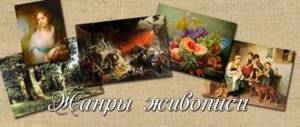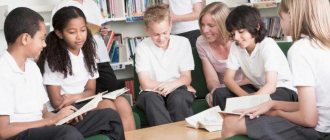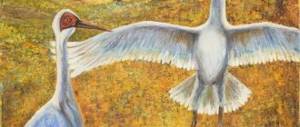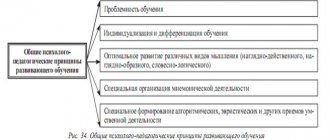Modern educational technologies in art lessons
Bulgakova V.M.
art teacher
MBOU secondary school No. 37
Working on the problem of developing students' creative abilities in fine arts lessons, I became convinced that significant pedagogical efforts must be directed to motivating students, therefore I use developmental technologies that activate students' activities. These include gaming technologies .
Playing in class helps me quickly involve all participants in the activity, evokes an emotional mood, which helps to establish close contact with students, and encourages active work.
With the help of didactic games “News from the Ship”, “At the Fork of Three Roads”, “Magic Carpets” I teach fifth graders the emotional perception of color. The colors of good and evil, joy and despondency must be different.
In the “Still Life” lesson in the sixth grade, I teach the game “We compose ourselves.” I propose to analyze the still life paintings of I.T. Khrutsky “Flowers and Fruits”, V. Stozharov “Flax”, I. Mashkov “Moscow Food: Breads”. What can these objects tell us? Children are given the task of writing a story. Some children came up with a story easily, while others had difficulty. From the stories, I can see which of the children have a fairly developed imagination, and which needs to be developed in this direction.
I use the transformation technique in different lessons. For example, in the lesson “These funny animals” I give the task: “Imagine yourself as a cat, remember how it moves, purrs, caresses. Do the same." “Imagine yourself as an astronaut who meets aliens.” “Imagine yourself as a hero who finds himself in the kingdom of Good or Evil. What fairy-tale characters live there? What animals, birds, insects live there? What colors can be used to depict the kingdom of Good and the kingdom of Evil? By transforming into different images, children become “artists” and stop feeling constrained. Their drawings turn out more “alive”.
In color science lessons I use the game “Magic Palette”. I encourage students to become experimenters and conduct some research. An experiment is being conducted to mix colors. Thanks to this game, students can easily mix and match the colors needed for their drawings and learn to distinguish shades of color. With the help of the game “Multi-colored lotto”, students get acquainted with and remember the names of colors, learn to distribute them into groups (primary, composite, additional) and by scale (warm, cold, achromatic), learn to distribute colors according to their gradation (from light to dark and vice versa ).
Games in "Blotography" help to develop the eye, coordination and strength of movements, fantasy and imagination. They peer at the blots and with great pleasure turn them into birds, animals, fish, and fairy-tale characters. Using a cocktail straw, a blot can be turned into an ikebana. By blowing, blots are transformed into stems, flowers, branches, and twigs.
Didactic games are very popular among children: “Exhibition of paintings”, “Find the mistake”, “Art salon”, “Confusion”, “Similar or dissimilar”, “Live paintings”, “Musical riddle”, “Joy or sadness”, “ Collect a postcard”, “Tubik’s artist exam”. With the help of computer games: “Quiet, the exam is in progress!”, “Interactive tests” on types and genres of fine arts, students generalize the knowledge acquired in fine arts lessons.
By solving crosswords or puzzles in fine arts lessons, students consolidate their knowledge of painting, graphics, sculpture, accumulate a stock of artistic terms and visual images, and learn to love and understand art.
“Distance travel” games, which invite participants on an exciting journey, are of great educational interest. This type includes the lesson “Journey to the world of beauty, to the world of nature.” This lesson fosters children's love for their native nature, interest in the work of poets, musicians and artists who describe the beauty of nature. Through music, poetry, and painting, I encourage children to think creatively about nature in their drawings. I’m playing a game: “What music sounds, what paint speaks?” (A piece of music is played and the children select one painting and poem that is in tune with the mood, talk about their feelings and experiences).
Conversations about fine arts are an important means of not only aesthetic, but also ideological and political education of students. During conversations, I show children pictures that reflect the nature of our Motherland, capture events from the history of the country, portraits of people who glorified the Fatherland. When in class I show a reproduction of a painting in which the artist’s patriotic feeling and his love for his native nature are clearly expressed, this also evokes in children a feeling of love and admiration for their Motherland . conversations and dialogues with children about works of Russian classical genre painting on the topic “The House and Its Inhabitants.” The idea of the conversation is to study how the artist reveals in the image the connection between the appearance of a house and the personality and life of its owners, how a work of art reveals a person’s ability to aesthetically transform the world around us. I conduct conversations and dialogues based on the works of: V. Borovikovsky. “Portrait of D. A. Derzhavina”, P. Fedotov. “Anchor, another anchor!”, “Breakfast of an aristocrat”, V. Perov “Arrival of a governess at a merchant’s house”, F. S. Zhuravlev “Before the crown”, “Fashionable wife”, F. S. Rokotov “Portrait of I. I. Betsky."
| < Previous | Next > |






